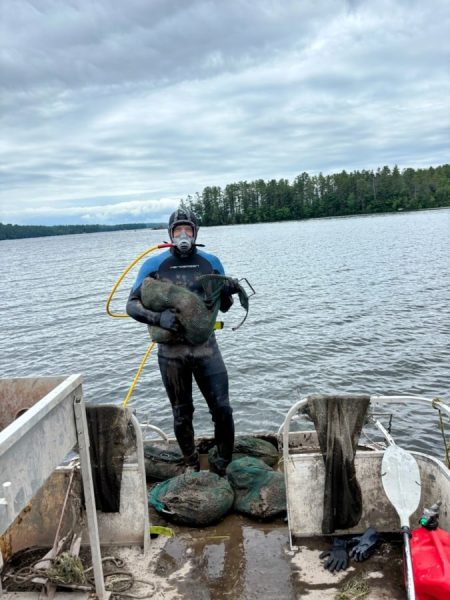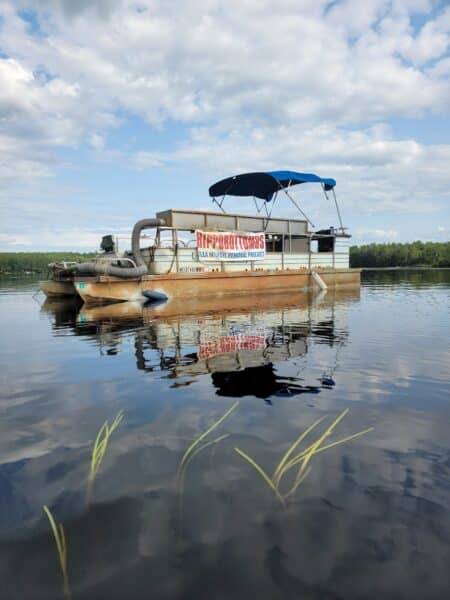What is TLEA Doing?
In 2005, concerned residents of the Otisfield and Edwards Cove areas began to mitigate milfoil in their section of the lake.
In 2005, concerned residents of the Otisfield and Edwards Cove areas began to mitigate milfoil in their section of the lake.
 They started a process of fabricating and deploying several 30’ x 30’ benthic barriers (tarps) to smother the plants. They initially had good success, although confined to their small area. They realized the magnitude of the problem and sought the assistance of the Thompson Lake Environmental Association.
They started a process of fabricating and deploying several 30’ x 30’ benthic barriers (tarps) to smother the plants. They initially had good success, although confined to their small area. They realized the magnitude of the problem and sought the assistance of the Thompson Lake Environmental Association.
TLEA took over and expanded the program in 2007. We recognized that this required a comprehensive and long-term approach. We began networking with other lake associations to learn the best techniques for milfoil management. To fund this effort, TLEA applied for environmental grants and made direct appeals to lakefront property owners. Contract divers were hired annually to do the work of hand pulling or suctioning milfoil from the waters, and to place the benthic barriers. A survey of the entire lake was performed, and a management plan was put in place to reduce, if not eliminate milfoil throughout the lake.
By 2016, 225,840 pounds of milfoil (over 100 TONS) had been removed from the coves around the entire lake. However, a 10-acre area of infestation at the Pine Point remained that was too large for being pulled by hand by underwater divers. To avoid the fragmentation and spread of the milfoil a boat channel was created at Pine Point. However, this area remained the primary source for fragments breaking free and rooting in other areas on the lake. TLEA recognized that unless this area of infestation was removed much of the progress of the milfoil removal would eventually be undone.

TLEA hired a dedicated dive team to place tarps, or benthic barriers throughout the lake bed at Pine Point. The barriers, which smothered the plants, were placed over 1.5- 2 acre sections and rotated on a yearly basis. By 2021, most traces of milfoil were gone from Pine Point.
But warming weather caused regrowth, and during the two summers of 2022 and 2023, another 7 TONS of milfoil was hand pulled from the Pine Point area.
TLEA increased its efforts and in the summers of 2024 and 2025 another 15 TONS of milfoil was hand pulled and removed from the lake.
Our Milfoil Crew is presently a 3-person team led by Alex Bernardy, of Otisfield Cove. They work from our revamped pontoon boat, the “Hippobottomus”. This work horse of a boat has a suction harvester and an external air delivery system for divers as they locate and remove plants. Some days consist of hand pulling the plants from murky water in frigid temperatures. On good days, the crew is on the Hippo, diving with surface supplied air to locate and suction plants. The morselized plants are then packed into sacks and transported to outlying farms, where it is used for fertilizer. Recently the crew has concentrated on hand pulling of plants in the shallow coves, especially at the Pismo beach area and around the Oxford dam, which is the outlet of the lake.
It is clear that the battle is not over, in fact, it may never be over. But with the support of our members, TLEA will continue to reinspect sites of previous milfoil infestation and will continue hiring divers to remove all milfoil that can be found.